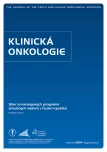Results of the Czech National Cervical Cancer Screening Programme
Authors:
J. Dušková 1,2,3; A. Beková 3; V. Dvořák 4; O. Májek 5,6; L. Dušek 5,6
Authors‘ workplace:
Ústav patologie, 1. LF UK a VFN a Katedra patologie IPVZ, Praha
1; Vysoká škola zdravotnická, o. p. s., Praha
2; CGOP, s. r. o., Praha
3; Centrum ambulantní gynekologie a primární péče, Brno
4; Institut bio statistiky a analýz, LF a PřF MU, Brno
5; Ústav zdravotnických informací a statistiky ČR, Praha
6
Published in:
Klin Onkol 2014; 27(Supplementum 2): 79-86
doi:
https://doi.org/10.14735/amko20142S79
Overview
Introduction:
The nationwide Cervical Cancer Screening Programme in the Czech Republic was introduced in 2009. The aim of this article is to describe the results of this programme in the first few years after its transformation into a fully-fledged, organised programme.
Material and Methods:
During the first few years, a network of 37 accredited laboratories was stabilised, ensuring that examinations would be readily available across the Czech Republic. Although all women aged between 25 and 70 years fall within the target group of the current personalised invitation programme, women not in this age group are reimbursed for preventive screening examinations as well. The programme is equipped with an information support provided by the Institute of Biostatistics and Analyses of the Masaryk University, which runs the Cervical Cancer Screening Registry. Results: Cervical cancer incidence and mortality rates in the Czech Republic have seen a significant decrease over the last decade. By the end of 2013, more than 11 million examinations were reported to the registry by the accredited laboratories, and more than 15,000 serious cervical lesions were detected. Analysis of the data from the registry makes it possible to monitor the quality of individual laboratories and the effectiveness of the entire programme.
Conclusion:
The promising start of the programme provides a strong argument for its continuation. The programme has the potential to decrease cervical cancer incidence rates in the Czech Republic to values comparable with those reported by countries with advanced health care systems.
Key words:
cervical cancer – population‑based screening – cytology – health care quality indicators
This study was supported by the project 36/14//NAP “Development and implementation of methodology for the evaluation of effectiveness of personalised invitations of citizens to cancer screening programmes” as part of the programme of the Czech Ministry of Health “National action plans and conceptions”.
The authors declare they have no potential conflicts of interest concerning drugs, products, or services used in the study.
The Editorial Board declares that the manuscript met the ICMJE “uniform requirements” for biomedical papers.
Submitted:
25. 9. 2014
Accepted:
21. 10. 2014
Sources
1. Dušek L, Mužík J, Kubásek M et al (eds). Epidemiologie zhoubných nádorů v České republice [Internet]. Brno: Masarykova univerzita; 2005 [citováno 30. srpna 2014]. Dostupný z: http:/ / www.svod.cz.
2. Kritéria a podmínky programu pro screening karcinomu děložního hrdla v ČR, Věstník MZ ČR, částka 7, září 2007: 147– 151.
3. Vyhláška MZ ČR č. 3/ 2010 Sb. o stanovení obsahu a časového rozmezí preventivních prohlídek.
4. The 1988 Bethesda System for reporting cervical vaginal cytologic diagnoses – developed and approved at the National Cancer Institute Workshop in Bethesda, Md, December 12– 13, 1988. Diagn Cytopathol 1989; 5(3): 331– 334.
5. Salomon D, Nayar R (eds). The Bethesda system for reporting cervical cytology. definitions, criteria, and explanatory notes. 2nd ed. New York: Springer 2004.
6. IARC Working Group on the Evaluation of Cancer‑ Preventive Strategies, Cervix cancer screening. IARC handbooks of cancer prevention. Lyon: IARC Press 2005.
7. Hakama M, Rasanen‑ Virtanen U. Effect of a mass screening program on the risk of cervical cancer. Am J Epidemiol 1976; 103(5): 512– 517.
8. Lăără E, Day NE, Hakama M. Trends in mortality from cervical cancer in the Nordic countries: association with organised screening programmes. Lancet 1987; 1(8544): 1247– 1249.
9. Pluta M. Konsensus pro řešení abnormálních nálezů ve screeningu cervikálních karcinomů. Gynekologie po promoci 2009; 9(2): 51– 58.
10. Arbyn M, Anttila A, Jordan J et al (eds). European guidelines for quality assurance in cervical cancer screening. 2nd ed. Luxembourg: European Communities 2008.
11. Májek O, Dvořák V, Dušek L et al (eds). Cervix.cz – Program cervikálního screeningu v České republice [Internet]. Brno: Masarykova univerzita; 2014 [citováno 29. srpna 2014]. Dostupný z: http:/ / www.cervix.cz.
12. Majek O, Danes J, Zavoral M et al. Czech National Cancer Screening Programmes in 2010. Klin Onkol 2010; 23(5): 343– 353.
13. Dusek L, Muzik J, Gelnarova E et al. Cancer incidence and mortality in the Czech Republic. Klin Onkol 2010; 23(5): 311– 324.
14. dos Santos Silva I (ed.). Cancer Epidemiology: principles and methods. Lyon: International Agency for Research on Cancer 1999.
15. Forte T, Lockwood GA, McLachlin CM et al. A first look at participation rates in cervical cancer screening programs in Canada. Curr Oncol 2012; 19(5): 269– 271. doi: 10.3747/ co.19.1188.
16. Arbyn M, Fabri V, Temmerman M et al. Attendance at cervical cancer screening and use of diagnostic and therapeutic procedures on the uterine cervix assessed from individual health insurance data (Belgium, 2002– 2006). PLoS One 2014; 9(4): e92615. doi: 10.1371/ journal.pone.0092615.
17. Nieminen P, Kallio M, Anttila A et al. Organised vs. spontaneous pap‑ smear screening for cervical cancer: a case‑ control study. Int J Cancer 1999; 83(1): 55– 58.
Labels
Paediatric clinical oncology Surgery Clinical oncologyArticle was published in
Clinical Oncology

2014 Issue Supplementum 2
- Metamizole vs. Tramadol in Postoperative Analgesia
- Metamizole at a Glance and in Practice – Effective Non-Opioid Analgesic for All Ages
- Spasmolytic Effect of Metamizole
- The Importance of Hydration in Wound Healing
- Obstacle Called Vasospasm: Which Solution Is Most Effective in Microsurgery and How to Pharmacologically Assist It?
Most read in this issue
- Performance Indicators in Screening Programmes
- Results of the Czech National Cervical Cancer Screening Programme
- Results of the Czech National Breast Cancer Screening Programme
- Results of the Czech National Colorectal Cancer Screening Programme – Colonoscopy Examinations
